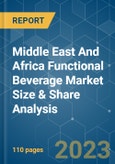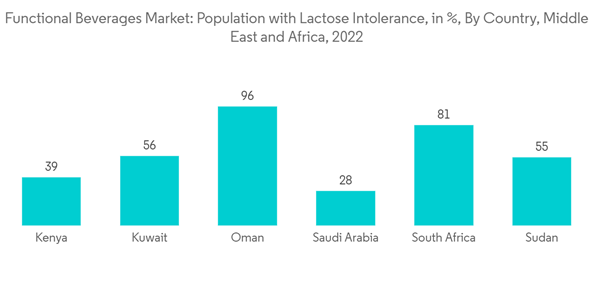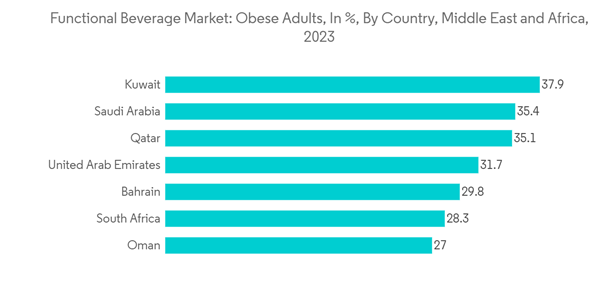Key Highlights
- Functional beverages are becoming increasingly popular among millennials due to rising advertising and promotional spending, largely because of aggressive marketing initiatives aimed at this demographic. Additionally, ads for energy drinks portray them as beverages that energize the intellect, revive the body, and improve performance and stamina. For Instance, in 2021, the consumption of packaged beverages in Africa and the Middle East totaled nearly 118 billion liters, according to Krones.
- The functional beverage market in the Middle East and Africa is embracing a growth phase with new flavor formulations, reduced sugar, calories, and ingredients innovations such as botanicals and herbs. For Coca-Cola, South Africa offers an energy drink called Coca-Cola Energy. The drink, available in a 300ml can, contains caffeine, guarana extracts, B vitamins, and no taurine.
- Moreover, consumers are becoming increasingly health-conscious and interested in trying new, better food options as worries about obesity, chronic illnesses, and other health problems increase. Incorporating functional drinks into one's daily routine is a simple and easy approach to increasing one's intake of essential nutrients, vitamins, and minerals. In addition, functional beverages frequently contain all-natural and plant-based components, which are becoming increasingly appealing to consumers.
- Also, reduced-sugar beverages are likely to gain popularity as people make a consumption-pattern shift to avoid diabetic symptoms. The probiotic drinks segment is also expected to witness many new buyers due to the growing concern about strengthening immunity. Manufacturers of functional beverages are predicted to increasingly shift towards online channels as more customers grow familiar and comfortable with the online and DTC distribution methods in the coming years. In addition, students and office employees are increasingly substituting energy drinks for coffee. Additionally, these energy drinks are gaining popularity as alcoholic cocktail mixers.
MEA Functional Beverages Market Trends
Growing Demand for Plant-based and Lactose-free Products
- With the growing population with lactose intolerance, the demand for lactose-free beverages has surged in past years. Hence the demand for lactose-free functional beverages in this section of customers has increased from time to time. The best alternative for these products was sourced and manufactured from plants.
- Functional beverages are often offered along with drinkable yogurts, milkshakes, and other dairy-related products. These beverages include energy drinks, sports drinks, and other types of juices. The majority of plant-based products are offered in dairy-based beverages like milkshakes, drinkable yogurts, and other drinks. Also, rising per capita income in Middle Eastern countries may contribute to the growth of the functional beverages market. The demand for lactose-free beverages has increased recently due to the expanding population with lactose sensitivity.
- According to the article published by the National Centre For Biotechnology Information in June 2022, on “Awareness of Lactose Intolerance Disorder in Saudi Arabia Population,” one out of three people in Saudi Arabia is said to be lactose intolerant. Because of this, the demand for lactose-free functional beverages among the consumer base has been increasing consistently. These drinks include juices of various kinds, sports drinks, and energy drinks.
- The bulk of plant-based foods and goods are available in dairy-based drinks, including milkshakes and drinkable yogurts. Also, due to the tax imposition on carbonated and energy drinks in 2017, more functional beverages are coming up, as consumers prefer beverages with no added sugar, high juice content, and fortified with vitamins and minerals.
- Additionally, regulatory changes in the declaration of synthetic colorants like allura red AC (INS 129), sunset yellow (INS 110), etc., would contain on-pack labeling. Thus, to impart competitiveness, manufacturers were replacing synthetic dyes with natural solutions, such as natural colors made exclusively from fruits, vegetables, and herbs.
Increasing Demand for Healthy Drinks
- As people adopt a mindset of indulging more in physical activities and other health benefits, functional beverages are becoming increasingly popular in the region. Because many products with various tastes and forms are being introduced into the market. Drinkable yogurt, kefir, buttermilk, and other fermented and functional probiotic beverages are popular among consumers in the region, while fortification of probiotic cultures in fruit and vegetable juice is one of the primary elements propelling the market.
- Drinkable yogurt is still the most popular choice among Middle Eastern consumers. Manufacturers are also attempting to incorporate probiotics into classic items like labneh. With an increasing awareness of fitness and a healthy lifestyle, as well as a desire to participate in sports, sports drinks and energy drinks were also seen to increase in demand among the young population.
- Moreover, drinking beverages containing artificial sweeteners can also lead to weight gain and other health issues, including type 2 diabetes, heart disease, and others. It's for this reason that natural drinks, such as fruit juices without added preservatives, are becoming increasingly popular.
- The Organic Trade Association claims that GCC consumers are becoming more health-conscious due to the high prevalence of obesity in various GCC nations. This was especially true in the United Arab Emirates, where 40% of the population was obese as of 2022, according to the World Obesity Federation. Almost everything in the region now levies a levy on sodas and other sugary drinks to get consumers to choose healthier options. There is a growing demand for organic, sugar-free functional beverages in the region due to these considerations.
- Several probiotic beverages are available in the South African market, including health drink mixes and beverages linked with digestive health, such as kefir and kombucha. For instance, in December 2021, the FENIX CXT energy drink mix was launched in South Africa. This product is infused with Lactospore Bacillus coagulans, which support gut and brain function, promote digestive health, strengthen the stomach lining, and boost immune health, as claimed by the company.
MEA Functional Beverages Industry Overview
The market of functional beverages in the region is fragmented to an extent due to the restricted approach of players toward the diversely categorized beverages in terms of functionality. However, some of the major players have estimated the caliber of the market and have come up with innovations that might attract a large consumer base, regulating the overall market of functional beverages in the region. Alternatives to dairy-based functional beverages are one segment whose demand is increasing due to the consumer shift toward veganism. Nestle SA, Coca-Cola Company, and PepsiCo are the region's market leaders. Functional beverage manufacturers are increasing their focus on innovation and new product development to fulfill changing demands of the public.Additional Benefits:
- The market estimate (ME) sheet in Excel format
- 3 months of analyst support
Table of Contents
Companies Mentioned (Partial List)
A selection of companies mentioned in this report includes, but is not limited to:
- Nestle SA
- PepsiCo Inc.
- The Coca-Cola Company
- Red Bull GmbH
- Monster Beverage Corporation
- Mutalo Group
- Herbalife International of America Inc.
- Viju Industries Nigeria Ltd.
- Sapporo Holdings
- Dr Pepper Snapple
- iPRO Sport Distribution Limited
Methodology

LOADING...










